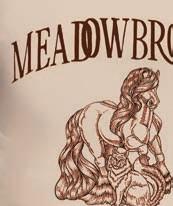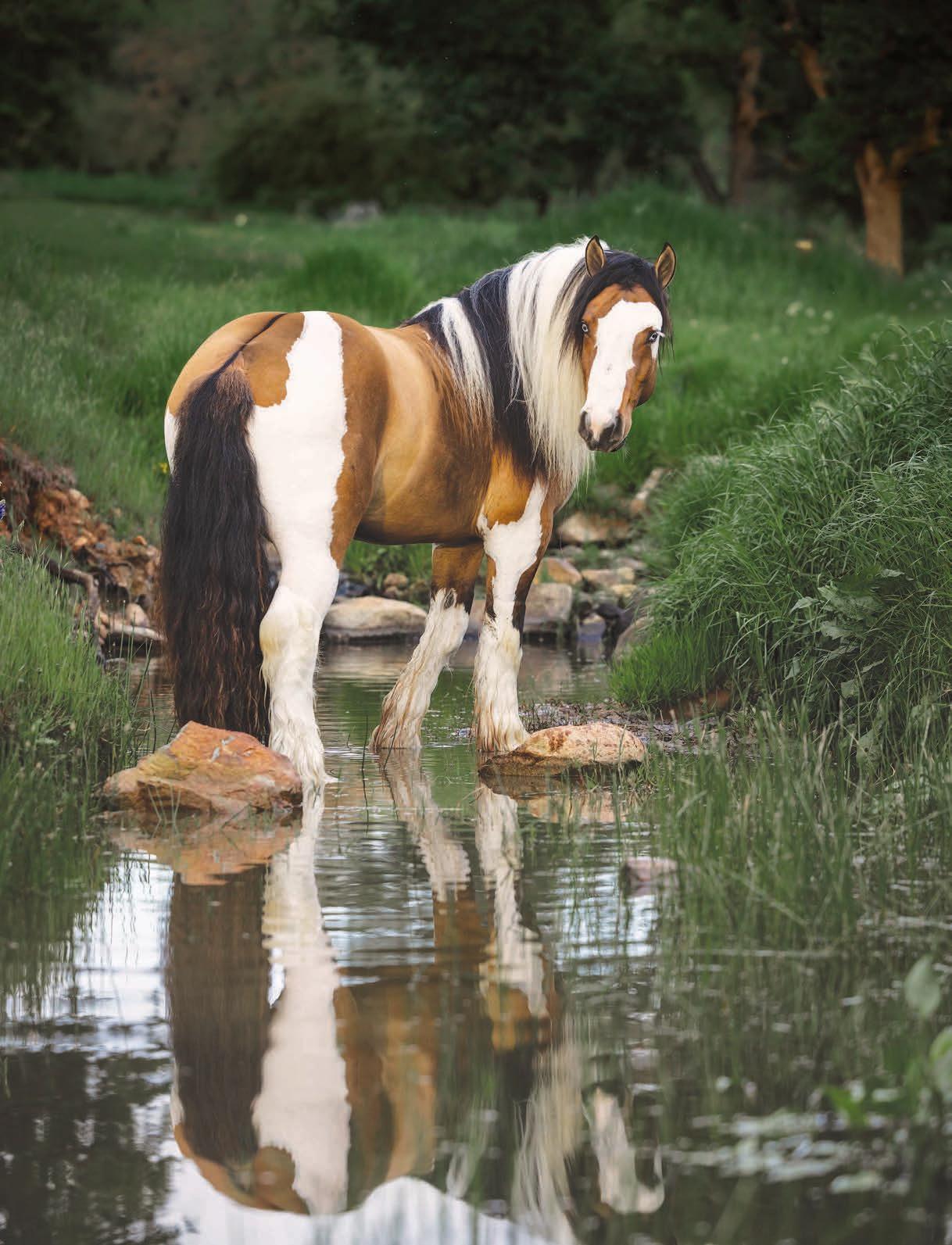

Homesteader

~ Your Guide to Rugged Outdoor Lifestyles ~


A desire to find the wild
5 hikes to take before the snow flies
Final garden chores to do before winter
Ethically raised goat meat in Bennington



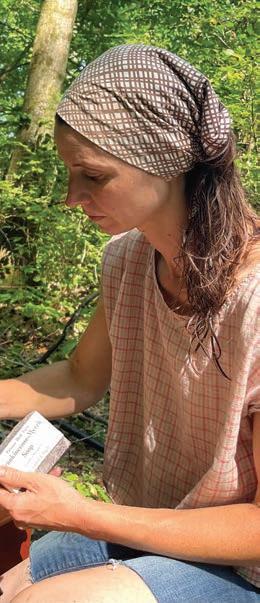

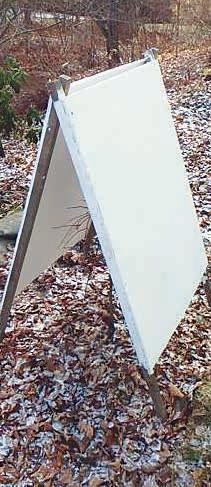
Meggie Baker
By Danielle M. Crosier
Henry Homeyer
Danielle M. Crosier

Ahmad Yassir
Katharine A. Jameson
Melinda Myers




Homesteader
~ Your Guide to Rugged Outdoor Lifestyles ~
President and Publisher
Jordan Brechenser jbrechenser@reformer.com
Content Editor
Lylah Wright lwright@reformer.com
Sales Managers
Lylah Wright lwright@reformer.com Susan Plaisance splaisance@ benningtonbanner.com
Digital Marketing Manager
Ahmad Yassir ayassir@ benningtonbanner.com

Sales Executives
Richard Lolatte rlolatte@reformer.com
Richard Battista rbattista@reformer.com
Kelly Palecek kpalecek@ benningtonbanner.com
Magazine




Photo
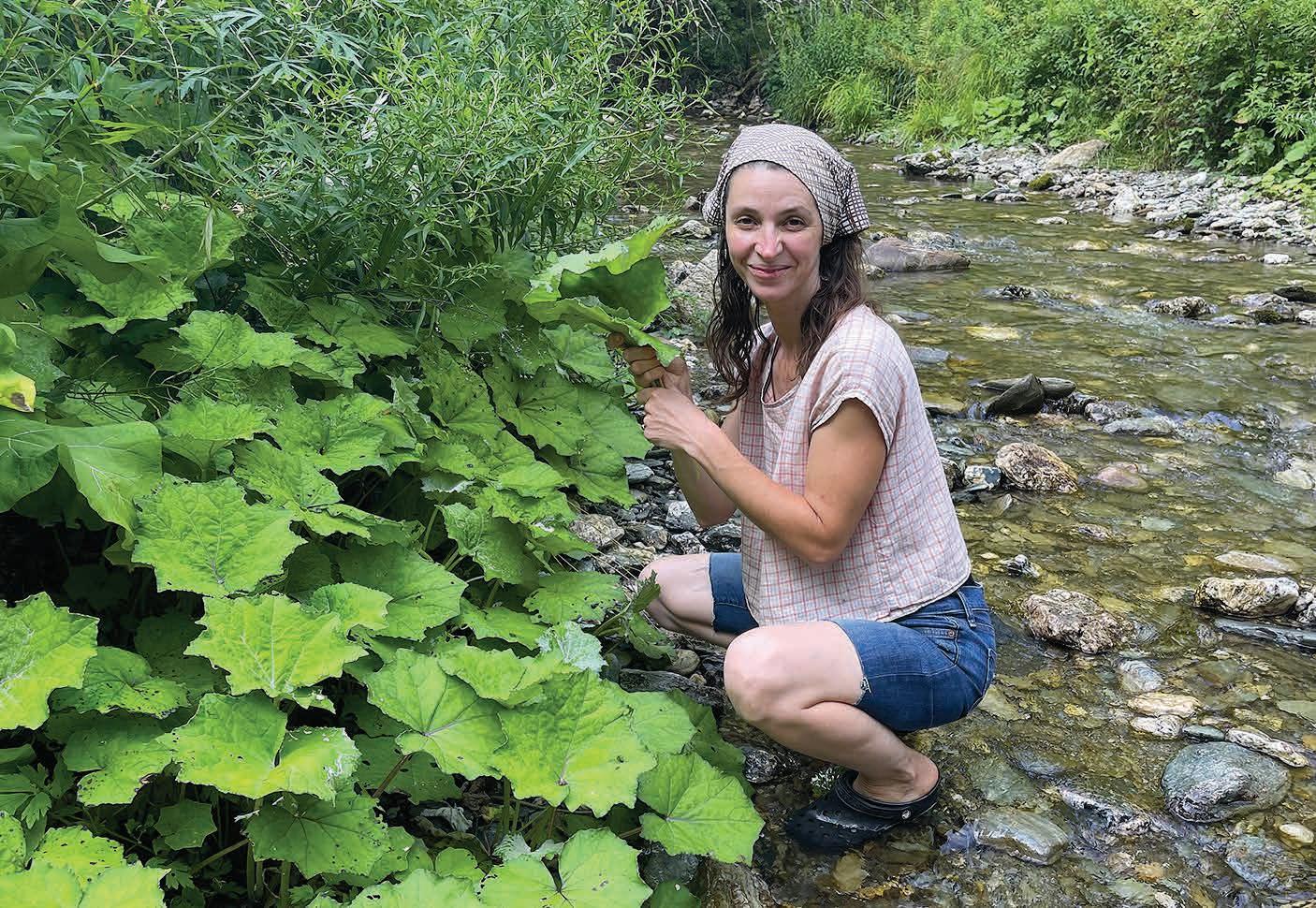
‘A desire to find the wild’
By Danielle M. Crosier Homesteader Magazine
SHAFTSBURY — Since she was very young, herbalist, author, and astrologer Lindsey Pszwaro has felt the most at home in the great outdoors.
“The most vivid memories that I have are of me when I was a little girl, picking white clover in our backyard and making clover chain necklaces and jewelry and just sitting, you know – in the shade, and on my back in the grass, and
looking at the clouds,” recalled Pszwaro. “Those are the most vivid memories that I have of being in a place of joy and total bliss.”
Now, she is trying to cultivate that sense of enjoyment, peaceful wonder, and kinship with nature in her two young children –Penelope, 8, and Oscar, 4. Both young children are homeschooled, raised “in the wilds” on the new homestead of Panacea in Shaftsbury, and the family joins six other families weekly in a collaborative “forest
school group.”
“I think I’ve always been a bit of a healer and a helper, and that’s sort of where the herbal medicine came in,” explained Pszwaro, who went to school for anthropology. Growing up in the suburbs of Philadelphia, Pszwaro described her childhood as great –and with a wonderful family. However, she felt restless to experience what the world offered, and “a desire to find the wild.”
WILD, Page 6

Homesteader, astrologer, herbalist, and author Lindsey Pszwaro lives in Sha sbury and runs Panacea Herb Farm.
PHOTOS PROVIDED BY PANACEA HERB FARM
The wild places are where Pszwaro finds the most joy and the most abundance, like in this special spot on their land where the coltsfoot grows alongside mugwort and peppermint. The Pszwaros call it “medicine island,” as dock root, thimble berries, and nettle also line the rocky banks.


Wild
from page 5
It was with that heart, yearning for a deeper connection to the earth, that Pszwaro was first able to explore. And, just barely out of college, it was on a trip to South Africa to study primates and primatology that Pszwaro first felt a glimmer of it.
“The different paths that get us to a place are always so unpredictable,” laughed Pszwaro. “I really knew that I wanted to travel, and I knew that I wanted to live in the woods. I wanted to just find and observe the wild places. I’ve always been fascinated with just –human condition, and what makes us human, and human nature. At the core of it, I was just searching for what connects us, and what separates us from the quote unquote animals, and what is in our nature. It just takes a little bit of observation and sensitivity – and, that brought me to studying Evolutionary Anthropology, and primates in particular.”
In South Africa, Pszwaro spent a number of months at the Lajuma Research Facility, following the blue monkeys – the samangos.
“We were on a mountainside, and there were people there studying anything from bush babies to leopards to certain kinds of birds or insects that are only found in that region,” recalled Pszwaro. “We were just gathering data, and I just really appreciated the way that we lived so simply. And so, it was like a
worldview change because I was in this place, on the other side of the world, and it made me feel more myself than ever.”
In Lajuma, Pszwaro said, she found that life was simply connected and interconnected. The heat of the outdoor oven radiated warmth to the water pipes. The group cooked over the fire, and then took their showers. Those with particular skills, shared them with the group. Life was peaceable, and it made great sense.
“The design of how energy is used and how to live – I feel like that’s where I first really picked up on where we got our resources from, and how we power our daily needs – whether it’s our drinking water or groceries, or the things that we grow and how we use them,” said Pszwaro. “But I also was really fascinated with the plants that the monkeys were using. They were dropping fruits, and they were eating leaves, and sometimes they would be rubbing certain leaves on them, and I wondered, ‘why that leaf?’ And, it was what sparked more interest in herbal medicine.”
Fascinated, Pszwaro explored the next possible project – a trip to Indonesia to study orangutan behavior, and their use of and knowledge of native plants. Pszwaro, however, never did go on that expedition to study orangutans. She met her husband – and life opened up another path.
“I met my husband right before I was supposed to go, and I had to make this
PHOTOS PROVIDED BY PANACEA HERB FARM
TOP: Lindsey Pszwaro checks her stock before heading out to the farmers markets.
BOTTOM: Oscar and Penelope help with the harvesting in the wild gardens of Panacea.
decision – do I leave Nantucket for this trip that is going to be amazing, or do I leave this amazing man? And, when you first meet someone that you connect with – it’s very special.”
What Pszwaro realized was that there were other ways for her to do work that was similar to where her interest lay, and that she “didn’t have to follow around primates to do it.” First, she learned the skills of an herbalist through an apprenticeship on Cape Cod. Then, as she and her husband began to plan the life they wanted; they worked –she at a Waldorf School and he as a carpenter. Their early journey took them out to Portland OR, and then back to Nantucket.
The path to creating this new chapter of their lives began with a simple list –detailing the parameters of what kind of land they wanted. They wanted space – wild space to raise their kids on. It should be in the Northeast. It had to have a considerable amount of acreage. It had to be at least 20 minutes from a town; it had to have running water on the property; there had to be land appropriate for agriculture, and have a spot to build a cabin. And, “Vermont really always stood out to us as a magical place – just with the mountains and the green and the culture.”
“One night at midnight, Aaron woke me up and said, ‘Lindsey, I think I found it,” Pszwaro recalled. The land he had found was located just outside of Bennington, a town that the couple were already familiar with – as two of their friends from Nantucket had recently moved there. “‘Let’s go stay with them, and check it out,’ he said.”
“We came up the next day,” Pszwaro continued, “And, we came to the land, and I could hear the creek running from the car – and I just started bee-lining it to the creek. As soon as I saw where the water ran through, it just felt like that was the soul of the land speaking to me – I just kind of fell to my knees and started crying. It was so powerful. It was just like – ahh, this is where we’re supposed to be.”
Arriving in Shaftsbury in 2020, the couple spent the first two years homesteading during the spring, summer, and fall months – and then overwintering back in Nantucket. They moved here full time right before Pszwaro gave birth to Oscar.
“I gave birth a month early,” said Pszwaro. “I don’t know what I was thinking but, in my mind, it was going to work out. And so, that was the biggest challenge – having this newborn and not quite having the life I had envisioned we’d have. And, being here, it was very isolating at first – not just physically or mentally, but emotionally. When people used to do this, they did it in communities. This was very different – when you’re on your own. It was so difficult, and there were so many moments in the beginning in the van or the tent where I was like, ‘Oh my gosh, what am I doing? I just want to go rent a cushy hotel for a night.’ Like, on a really cold night or a stormy night, it was really hard, but I think that’s where resilience comes in – for my own lessons, and what I’m trying to teach my kids.”
“It was mostly just like, psychologically – how are we going to navigate living here, surviving here, build-
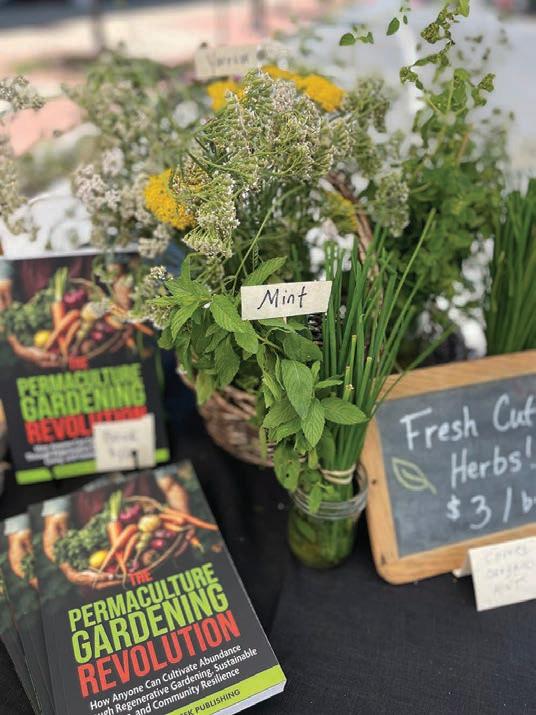
ing here,” remembered Pszwaro. “And, when you have a baby, that root chakra is already a little unstable. It took some time. I would say, it was only when Oscar was about two, did I realize that I was probably suffering postpartum depression.”
It was during this time, Pszwaro said, that a plant called to her. That plant, with its buttery yellow flowers and its tall sun-seeking stalks, was Saint John’s Wort.
“I just recently taught a class in the spring on herbs, and I covered my 10 or 15 favorite herbs for stress and anxiety – and, Saint John’s Wort was definitely number one,” said Pszwaro. “I opened with,
‘I don’t know if any of you have ever had a plant save your life, but when you do, it changes you.’ For me, that plant was Saint John’s Wort, and I truly believe that the plants we need the most will show themselves to you when you least expect it. Then, there’s motherwort and plantain and chickweed and mugwort. They just keep popping up.”
Now, it is these anti-inflammatory and healing herbs – and others – that Pszwaro makes her tinctures and salves from, but back when she still had her young baby, they were lifesaving – bringing a sense of centered stability and calm to her life once again.
WILD, Page 8
The farmers market tables for Panacea Herb Farm usually host a few copies of Pszwaro’s book, fresh medicinal flowers and herbs, teas and tinctures, salves, candles, soaps, and more.
from page 7
“We were just getting acclimated to the land,” recalled Pszwaro, of a particularly troubling period when they didn’t really know their neighbors. It was during this time that they experienced difficulties with late night ATVers on their new land.
“I wanted to feel protected. I didn’t know who these people were – and they were coming in the middle of the night with their loud machines, driving on the path right in front of where we were camping and, with a baby, I was feeling a little unsafe and unsure. But, I feel like we quickly really fell into a great community.”
Making friends with a local midwife who ran a nearby farm, and with help from their friends in Bennington, the couple forged on. The local midwife, owner of Grateful Morning Farm in Shaftsbury, offered Pszwaro the use of her farm stand to sell tinctures, salves, and flower essences. And, that was the start of Panacea, Pszwaro’s business. Building a home, building a family, building a business – things finally began falling into place.
Now, Pszwaro and her family live nearly completely off the grid. The children help her with wildcrafting and harvesting.
“Our four year old likes to be held, so he’s my helper,” said Pszwaro, laughing. “There’s a lot of hygiene involved, so they don’t help with the tea blending or the things that involve more cleanliness actions, but when it comes to harvesting, they love doing that – and drying and labeling.
They really like putting the labels on the bottles.”
The children also like saving monarchs, “We found out that only 10% of the caterpillars in the wild make it from caterpillar to butterfly,” Pszwaro said, “but, if you take the eggs of the caterpillars and you feed them the milkweed leaves every day, and you get them to chrysalis and open, it’s about 90% – so we’ve really been working to try to collect as many as we can. We have probably over 50. It’s really important, I think, to let the wild places happen because our pollinators need it, and we need pollinators.”
Pszwaro uses a solar dehydrator to dry all of her herbs. She attends three or more farmers markets or craft markets a week, and runs her home-based business. She hosts in-depth star chart and astrology readings, and just recently authored the book, The Permaculture Gardening Revolution.
She does all of her cooking on a propane stove that sits just outside of the cabin that her husband built.
Pszwaro’s husband, Aaron, is a freelance carpenter – working locally in Southern Vermont, “He’s very creative and good at solving problems – like when it came to building the house, and hooking up the solar power, and pumping the water, and setting up irrigation for our garden. The irrigation is mostly gravity fed from our spring – and that was a project that I couldn’t wrap my head around, but he just figured it out in a couple of days –and now our garden is getting watered without me being out there with watering cans for two hours.”
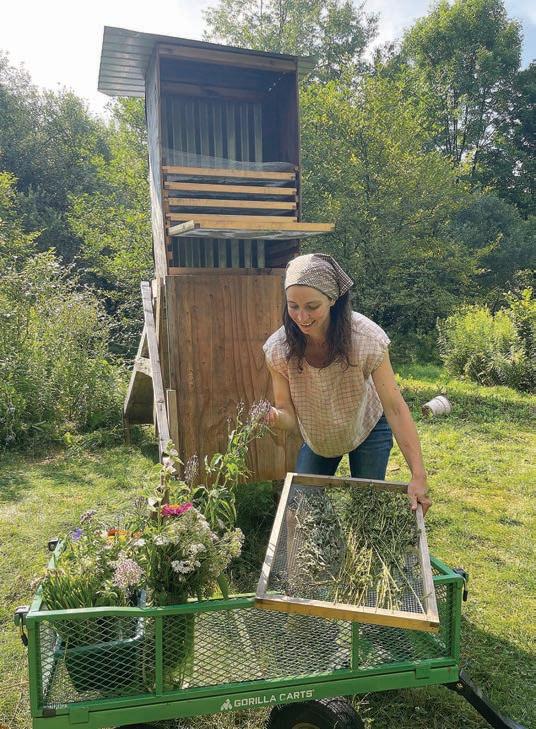
“He’s really a jack of all trades,” laughed Pszwaro. “When I met him, he was a potter. On Nantucket, he had his own pottery kiln that he built. Since he was 19, he’s been building wood fired kilns. That is a very intensive and very devoted form of art for him, very humbling. You know, it’s something where you put all this time into it, and it doesn’t always work. But, he’s very excited because he’s just started building his kiln here on our land –and connecting with some of the potters here. That’s where his heart is, is in the pottery.”
“He’s really more of a
historian with his pottery,” explained Pszwaro, adding that she hopes to include her husband’s pottery in her market stalls soon. “And, it’s really interesting. He likes to incorporate some of the old Japanese techniques, and all of his pieces look like they were artifacts – like dug out of the earth on an archeological dig. They’re so rustic and beautiful.”
The business, Panacea, is named after the Greek goddess of universal remedy – a connection that holds great significance to Pszwaro. Pszwaro also finds connection with the people that she meets at the mar-
Pszwaro dries most of her herbs in this solar dehydrator, built by her husband. The front of it absorbs the sunlight and sends heat to the dark box with the screens. In about two days time, the herbs are crispy and dry – but still nice and green, holding onto their medicinal qualities.
kets. She is rebuilding and expanding on her business website, and taking classes to continue her learning.
“My whole life I’ve had this inner motto of just following your heart and you won’t go wrong,” said Pszwaro. “If we have something in our life that is calling us to bring us joy and happiness, life is too short to not share your calling. I feel like we all came here with gifts to share, and it’s important for us to identify what those gifts are.”
Sometimes, it’s hard to envision your life in any meaningful way that is different from the current reality. It can be even harder to envision a life that is different from the norm, Pszwaro acknowledged. But, if you know what you want to do, the risk is worth it, she said. Pszwaro and her husband just did it – they took
that first step – without the safety net.
“I think I just took a step – just that first step,” she said, thinking. “And, I guess there’s a certain level of trust that I had to have with myself, with my partner, with just divine timing and seeing how it would work out. And also, I think part of that comes from seeing how other people do it with less, like in South Africa –and, when you have less, you actually have more.”
“There’s more space for you to do what you love,” continued Pszwaro, “there’s more space for joy, and there’s more space for discovery.”
Pszwaro can be found at the local farmers markets, and more information on her astrology readings and her herbal remedies can be found at panaceaskies.com.


On the outdoor propane camp stove, Pszwaro is re-melting and repurposing some imperfect beeswax candles that she had previously made. Pszwaro does most of her soapmaking, balm making, and candlemaking using this two-burner propane stove near the cabin.






PHOTOS PROVIDED BY PANACEA HERB FARM
YOUR BACKYARD COULD


Imagine opening your door to a yard filled with wildflowers and teeming with butterflies and songbirds. Imagine yard maintenance transformed from the joyless tasks of mowing and pruning into a simpler, more rewarding role of nurturing and curation. Imagine creating a landscape design that isn’t just ornamental beauty, but becomes a backyard nature preserve all your own.
If you think about it for a moment, you’ll realize we’ve been building ‘wrong’ for decades. We find a beautiful parcel just right for a dream home. But to build our dream home,
we tear open a scar in that beautiful parcel, build, and then cover the remains of the scar with lawn and landscape plants chosen for eye appeal. In doing so, we lose something precious: we’ve disturbed and altered the original biosphere, introduced plants that don’t belong, and created a desert island in the local food chain. In essence, we’ve destroyed the very thing that drew us to buy that beautiful parcel. But it doesn’t have to be that way.
A national movement to change the way we landscape and manage our residential properties has been helping more and more homeowners to take charge of the health of our local ecosystems. This is
more than planting native species and creating butterfly gardens, although those are important pieces. The idea is to build a healthy micro-ecosystem around our homes in which all orders of native species live and thrive together: microbes, insects, plants, and animals. With a little research and planning, you can create a nature preserve at home.
Geobarns has been building homes, utility buildings, and commercial venues for more than three decades, often in locations with strict conservation standards. Over the years, we’ve developed a robust process of ‘Site Stewardship’ to minimize the impact of construction and restore the natural land-
scape after completion. While our process is specific and unique to each of our clients’ building sites, our Site Stewardship principles can be applied anywhere.
Our foundational principle for conservation is simple: no matter what property any of us may own, we are all merely temporary caretakers. We must be good stewards of the land, to disturb it as little as possible, and to conserve and nourish it for future generations to enjoy as much as we do.
Geobarns believes that the design of our buildings and the experience living within them is linked to the health of the land surrounding them. Our well-
By Casey Williams Geobarns Site Steward
Virginia Homestead Barn Cistern
PHOTO BY MEREDITH COE
Classic Car and Family Barn
PHOTO BY JOHN SHERMAN
HELP SAVE THE PLANET!

being is dependent upon nature, the resources it provides, the forms of life it supports and the food it generates. Therefore, landscaping isn’t something done afterwards; it becomes an essential design element as important as siting, drainage, floorplan, and finishes. And it isn’t just ‘landscaping’… it’s restorative landscaping: repairing the impact of construction and restoring the original ecological web of species and relationships. This is essential to being a good steward of the land, whether a homeowner, builder, or designer.
Too often, we think of human activity and wildlife habitats as forces in
conflict. This doesn’t have to be true. Although human activity is negatively impacting our planet in many ways, we are a native species like any other. The conflict is easy to resolve.
The solution is to use our knowledge, science, and technology not simply to mitigate negative impacts, but to build a harmonious relationship between our human dwelling places and the natural environments where we build them. Your property and your home can be part of the solution while still providing the lifestyle you want. With forethought and planning, humans and the environment can flourish together.

Here are eight principles from our Site Stewardship process you can implement yourself:
• Incorporate a diversity of native plants, which provide habitat and food sources for insects at the bottom of the food chain.
• Minimize lawn and diversify these areas with clover, thyme and other low-growing herbs and legumes, which minimize fertilizer demand and provide nectar for local pollinators.
• Plant natural plant communities or guilds that are multifunctional and are naturally found growing together. These plants provide the benefits of natural fertilizing, repelling pests, attracting pollinators and other beneficial insects, creating mulch, and suppressing grass.
• Reduce use of pesticide, herbicide, soaps, driveway sealants and de-icing salts that are toxic to both terrestrial and aquatic ecosystems.
• Manage stormwater, minimize erosion, and enhance soil quality by adding compost, incorporating native plants, preventing compaction, and maintaining or establishing pathways and areas for infiltration.
• Conserve water by hydrozoning plantings and collecting roo op water for nonpotable uses, such as irrigating gardens, livestock, recreation, etc.
• Limit use of exterior lighting & incorporate “Dark Sky Lighting” to protect the night skies from light pollution, shield glare, and disruption to circadian rhythms and insect populations.
• Become an advocate for plant and insect conservation by helping to increase awareness and appreciation of insects and countering negative perceptions. This can also involve getting involved in local politics, supporting science and voting!
Resources Geobarns recommends:
Nature’s Best Hope by Doug Tallamy, Professor and Chair of the Department of Entomology and Wildlife Ecology at the University of Delaware
Audubon Native Plants Database: audubon.org/native-plants
Backyard Parks: HomegrownNationalPark.org
Geobarns is based in White River Junction, Vermont. Learn more at Geobarns.com

Bundoran Reserve
PHOTO BY MEREDITH COE
Chickahominy Falls Agrihood Community Center
PHOTO BY SARA EASTMAN WEIDNER


5 hikes to take before the snow flies
By MeGGie BaKer Homesteader Magazine
We’re all spending more time outdoors lately, and with colder weather not too far off, take advantage of the last of the warm days and hit the trails.
Fall in New England means hikers can enjoy a break from stifling heat and humidity and enjoy the
best foliage in the country.
The five hiking trails here offer something for everyone. If you are an experienced hiker looking for a little challenge, we’ve got something for you. And for anyone who might have only bought those hiking boots, don’t worry. We’ve got a few easier offerings for the novice.
In Southern Vermont
GLASTENBURY MOUNTAIN
Bennington & Shaftsbury
Glastenbury Mountain is a 20-plus-mile out-andback hike kicking off at the Long Trail-Appalachian Trail trailhead on Route 9, 5 miles east of Bennington. For anyone looking to avoid that first rough mile, alternately, begin at the Little Pond trailhead 9 miles east of Bennington and cut across at the sign for the LT-AT.
Wear layers, and bring warm gear: It’s windy at the top. It’s 9.8 miles to Goddard Shelter, so, leave early, and if you’re hoping to get a spot, leave earlier. Don’t worry, there are plenty of places to pitch
a tent around the shelter, (Recommended: There is a lovely composting toilet at the shelter and more tree coverage to block the wind) or at the fire tower. No potable water; bring enough or be ready to purify water you can get from a spring at the shelter.
LITTLE ROCK POND
Mount Tabor
Little Rock Pond trail via the Long Trail-Appalachian Trail is an easy, mostly flat 4.8-mile hike along a brook and then through some marshy forest, ending at the pond about 2 miles in. Don’t forget your bathing suit if you think you want a dip! There is a loop around the pond and first-come,
PHOTO BY CHRISTINA L. FLORADA
This aerial view of Glastenbury Mountain was taken from a Cessna airplane in April 2025.

first-serve camping platforms for those who want to stay the night. Don’t forget the bug spray.
MOUNT SNOW
Dover
Mount Snow is the place to enjoy fall foliage! Take the chairlift to the top and hike down, or, if you are
looking for a challenge, hike to the top and take the lift down.
If you are looking to enjoy more than just the trails during your visit to Mount Snow, there are lift rides, mountain activities, on-mountain dining, lodging and retail locations. Dogs are not permitted.
In the Berkshires
TACONIC CREST TRAIL IN PITTSFIELD STATE FOREST
Hancock
If you are looking for a beautiful autumn vista, hike a section of the Taconic Crest Trail in Pittsfield State Forest, from Potter Mountain Road to Berry Hill. This is a 6.2-mile outand-back hike with some ups and downs. The payoff is some sweeping panoramic views of New York’s Rensselaer Plateau to the west. And if you don’t have the time for a 6-mile hike, you always can meet up with the trail from Berry Pond Circuit Road.
MONUMENT MOUNTAIN RESERVATION
Route 7, Great Barrington
If you are looking for an easier day, hike the 1.5-mile Indian Monument Trail to the junction with Hickey Trail, then hop on Peeskawso Peak Trail for the best views, 7/10-mile before rejoining Indian Monument Trail. For a tougher challenge, hike Hickey Trail to Peeskawso Peak Trail to Indian Mountain Trail.
Parking is free for members and $5.00 for nonmembers.

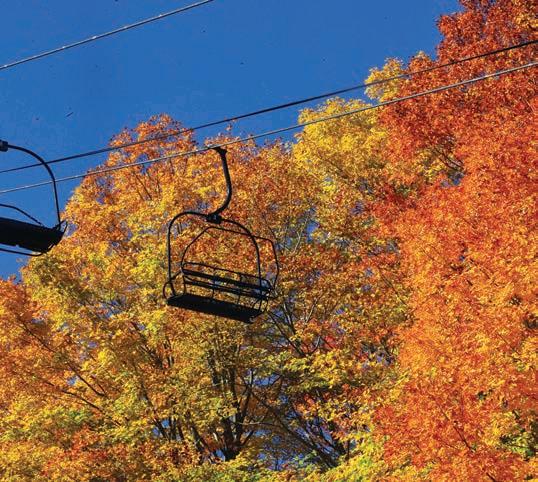
You can either take a chair li up the
and hike down or you can hike up and ride the
if you are up for the
People enjoy the Fall foliage and hiking trails at Mount Snow in Dover, VT.
PHOTOS BY KRISTOPHER RADDER — HOMESTEADER MAGAZINE
mountain
chair li back down,
challenge, at Mount Snow in Dover, VT.
‘The work of a lifetime’


Honey bees buzz on Putney Ridge
By BoB AUdette Homesteader Magazine
PUTNEY — It’s 10:30 on a wonderfully cool August morning, with the sun spilling across the forest and onto the fields as bees buzz and bumble in and out of a shed packed with hives on a hilltop in Putney.
“Right now, I have seven hives,” said Erik Johnson. “But I’m going to upgrade and get another 15 queens from Northwoods in Westfield.”
The honey produced by the bees at Putney Ridge Apiary starts off tangy on the tongue and eases into sweetness. As might be expected, it’s excellent in tea, but poured over vanilla ice cream it is exquisite.
“Putney Ridge Apiary bees forage on wildflowers and forest blossoms in Putney,” said Johnson. “This gives the honey a bright tang and a hint of spice, depending on what local blooms are in season, which help shape that flavor. It’s straight from the lands of Putney, no artificial flavoring needed, nor wanted.”
Putney Ridge honey can be found at the Putney Food Co-op, the Putney Diner, Green Mountain Orchards and Brilliance in Brattleboro, and can also be purchased online.
“You’ll see little specks in the honey, like yellow or black, which could be propolis, honeycomb, or pollen, all good stuff,” he said.
Johnson, who has a re-
sume that includes a bachelor’s degree in environmental science and 21 years with the Brattleboro Police Department’s crimes against children task force, kind of stumbled into beekeeping, but it seems to suit him well as he pokes and prods with bees swarming harmlessly around him.
“I have a friend in Newfane,” he said. “About four years ago he told me he had this old barn with a bunch of old beehives.”
Johnson got on the phone and called his niece, Jade Christensen in Maine, who has been keeping her own hives for a number of years and founded Forest City Beekeepers.
“She came down from Maine to make sure they were healthy and not infect-
ed with mites or beetles or moths,” said Johnson. Some of the old hives were not salvageable, he said, but he was able to save a pair that he could start with.
“It all went well until last year, when I lost all of my hives,” said Johnson, who said Honeybee populations across the country saw a 60 percent die-off last year, attributed to a number of factors, including pesticide use, colony collapse, and parasites and viruses.
He’s back up to seven hives now, and will be adding 15 more with starter kits coming from Northwoods Apiaries in Westfield. Those starter kits will triple his production of honey, but it’s not just about the sweet delicacy for Johnson: It’s also about his
PHOTOS BY KRISTOPHER RADDER — HOMESTEADER MAGAZINE

own connection to the land and his gratitude for what the land has given him.
“Every morning I have a teaspoon of honey,” he said, “and that’s one bee’s work in its lifetime.”
As he conducts his rounds, he talks about how a hive is started from a kit, or nucleus, and the differences between the types of honeybees. His favorite is the worker drone, sterile females that perform all the jobs necessary for the colony’s survival, from feeding larvae and building comb to guarding the hive and foraging for nectar and pollen. They also maintain the hive’s temperature and

humidity and possess specialized anatomical features like wax glands and pollen-collecting legs, and communicate through com-
plex dances and pheromones.
“The hive is an organism,” he said. “The bee is like a red blood cell, going
out and getting resources.”
Johnson learned a lot from his niece and from watching videos on YouTube. He built a shop vacuum attachment to gently suck the honeybees from the old hives. He squirts a couple of puffs of smoke at the hives, but he said the vacuum does a great job.
He said you can use most any kind of smoke to soothe the bees, but he prefers the wild sumac leaves that grow just a few feet away from his shed.
“It makes them a little more docile, but it also helps kill the mites that live on them,” he said.
Erick Johnson, owner of Putney Ridge Apiary, checks on the health of one of his hives on Tuesday, Aug. 19, 2025.
Henry Homeyer | Notes from the Garden:
Final garden chores to do before winter
By Henry Homeyer
Homesteader Correspondent
Winter is fast upon us. The shortest days of the year are ahead, but gardening is done for most of us. That being said, I still have flowers in bloom outside. My witch-hazel trees are showing gorgeous, twisty-petaled yellow flowers, even after a light snow and several hard touches of frost. And I still have a few blossoms on one of my ‘Knockout’ roses.
If you planted any trees or shrubs this year, make sure they go into the winter well-watered. We’ve had dry times this summer and fall, so a slow, deep watering is needed now. A woody plant’s roots are still growing now –even after leaf drop and until the ground freezes around them.
I’m not sure why, but I saw very few Asian jumping worms this summer – perhaps the hot, dry weather in-
hibited their spread. I think I only have them on one portion of my property, but I am being careful about the possibility of spreading egg cases. I like to chop up my fall leaves and save them for use in the garden, but I don’t do that with leaves in the area where I’ve seen those dreaded worms. Instead, I just use them for mulching beds that are already infected with invasive worms.
This is the time of year to think about protecting our woody plants from deer predation. I can’t afford to encircle our 2.5 acres of gardens with an eight-foot tall fence, the best way to protect plants. And Rowan, our four-year-old Golden/Irish Setter mix, helps discourage deer, but he lives indoors and sleeps by the fire all night –just when hungry deer are marauding. Winter is when they want to munch your rhododendrons and other yummy things.


A simple plywood A-frame will protect a shrub from snow and ice coming off the roof.
There are several ways to discourage deer. I have found that garlic clips attached to branches about three feet off the ground are good. I buy some called “Fend Off Deer and Rabbit Odor Clips.” These are little green plastic cylinders that contain garlic oil. They repel deer for up to five months. Unlike sprays that wash off after a hard rain, these really do a great job. I’ve seen footprints of deer that approached tasty shrubs, sniffed and walked away.
If you have had deer eat the lower branches of your yews, a favorite evergreen for deer, you can also protect your plants by wrapping them with burlap. Yes, it is tedious, but it is 100 percent effective. I have done it for years for a client.
Voles, chubby rodents with short tails, are common everywhere and love to nibble on the bark of young trees,
particularly fruit trees. You can protect your trees by placing a cylinder of quarter-inch “hardware cloth” around them. It comes in 18inch rolls, which you can cut with tin snips. Wear gloves; it’s razor-sharp when cut. But don’t let your tree engulf the wire – which it can do in 3 years or so.
I know that March is traditionally the time for pruning fruit trees, but November is fine, too. And you shouldn’t have to wade through deep snow to do so. A quick reminder of how to do this: Start by removing any dead or damaged branches. Next, evaluate the overall form of the tree: Is it a handsome plant? Can sunshine get to every branch? Is there clutter that should be removed? If so, get to those branches next. Evaluate the future of any branch in question: what will it be like in five years?
PHOTOS SUBMITTED BY HENRY HOMEYER
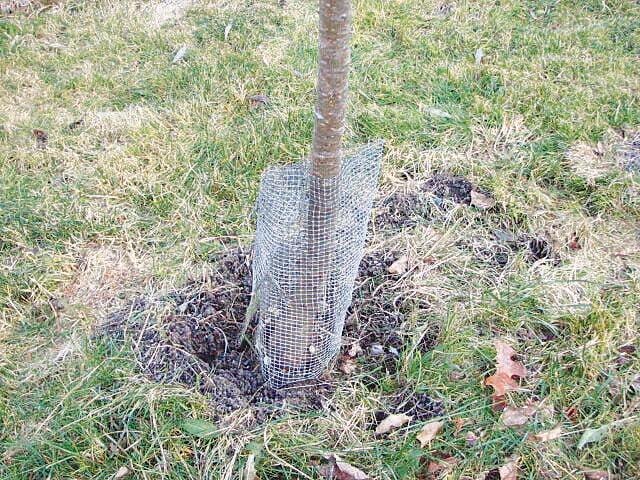
Branches on the outside of the tree that are headed back to the center of the tree should be removed. And of course, remove those pencil-thick upward racing water sprouts before they become big. Rubbing or crossing branches? “Off with their heads,” as the Red Queen would say in Alice in Wonderland.
It is not too late to plant spring bulbs. Selection in stores and online may be limited, but there is no such thing as a terrible tulip or disgusting daffodil. Daffodils are generally more successful than tulips as they are slightly toxic and not eaten by deer or rodents. But next spring, you can surround or cover your tulip beds with chicken wire to keep deer from eating them. I generally plant 100 tulips in my vegetable garden each year to use as cut flowers and as gifts for friends and the elderly. I treat them as annuals, pulling the bulbs to make room for tomatoes or lettuce in summer.
If the previous owners of your house planted shrubs around the house, snow from the roof may slide off and break branches, particularly if you now have a steel roof. You can save them by making

little plywood A-frames. Do this by screwing legs made of strapping or hardwood stakes onto lightweight plywood. Drill holes at the tops of the legs, allowing you to connect front and back with a piece of wire so you can spread the A-frame out as needed and fold it up to put away in spring.
Be sure to drain your hoses and put them away before winter.
Thanksgiving is coming. I celebrate the harvest, as well as my good health, good friends and family, and living in a safe part of the world. I make a point of celebrating by serving vegetables that I have grown myself. This year, I have, from my garden, potatoes, carrots, Brussels sprouts, Swiss chard, kale, Italian dandelion greens and garlic. And we’ll make extra applesauce to give to our guests.
So do a little more work in the garden now. It will help dispel the winter doldrums.
Henry lives and gardens in Cornish Flat, NH. E-mail him at henry.homeyer@comcast. net or write him at PO Box 364, Cornish Flat, NH 03746


Hardware cloth used to protect apple tree from voles.

By GreG SUKienniK Homesteader Magazine
Imagine a moment when all the cares of the world and your life — the job, the mortgage, all of it — disappears, and all that’s left is you and your natural surroundings.
It doesn’t require medication, virtual reality goggles or a sensory deprivation tank.
But you will need a fly fishing rod and reel, a few flies, and a commitment to learning a few skills in a world where you need to learn how to think like a fish.
That’s the magic of fly fishing, say the sport’s teachers and advocates. It draws you in so deeply, as you scan the water for the places fish loiter while awaiting their next meal, that the rest of the world disappears.
“It’s so meditative. It

The Allure of
really is an activity that forces one into being present,” says Whitney Milhoan, the executive director of Casting for Recovery, a Manchester, Vt.-based nonprofit that helps women recovering from breast cancer through fly fishing adventures.
Whether it’s untangling line or reading the water for where the fish are lurking, “you’re almost forced to let your mind rest and let go of all the other stressors of the outside world,” Milhoan says.
When you’re thinking like a fish, trying to find the “seam” in running water and scanning the water surface for evidence of where the food is, you’re not thinking about the mortgage, the car repair or the job. You’re at one with the environment that surrounds you — a literal statement if you’re wearing waders and standing in



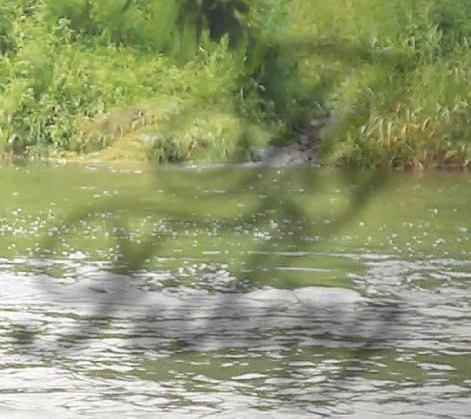
thigh-high water.
Harry Desmond of Berkshire Rivers Fly Fishing has seen how fly fishing relaxes people while leading casting lessons and excursions.
“I get a lot of city folks who stay in the Berkshires, people who are rookies at fly fishing,” Desmond says. “They’re full of energy and kind of hyper. They want to know where we’re fishing, they’ve already got their waders on.
“Get them into the water, and after an hour, you see folks let go. You can see it, you can feel it — they let go of the daily grind. I’ll hit people with a question when I see they’re in the zone — I’ll ask ‘What are you thinking?’ Ninety percent of the time they’ll say ‘Oh, nothing.’”
But isn’t fly fishing difficult to get into? All that equipment? All those fancy hand-tied flies? Isn’t it kind of expensive?
Not so. In fact, it’s never been easier to get started in the sport.
“Light years easier,” says Orvis marketing manager Tom Rosenbauer, who got started 50 years ago as a boy with a few library books and time to learn from his own mistakes. “Today, with much better books and thousands of internet videos and schools it’s a whole different story.”
And the Berkshires and Southern Vermont are great places to get started.
So let’s start where modern fly fishing in the United States began: Manchester, Vermont.
Here, nestled between the Taconic and Green Mountain ranges and alongside the Battenkill River, the legacy of Charles F. Orvis and his family is everywhere. The company he founded in 1856 as a mail-order specialty firm is headquartered just down
PHOTO COURTESY OF BERKSHIRE RIVERS FLY FISHING ADVENTURES
the road in Sunderland; it’s now owned by the Perkins family, which purchased the firm in 1965. The company’s flagship store, complete with trout ponds, is at 4180 Main Street (Historic Route 7A), within strolling distance from several hotels and inns.
You can immerse yourself the sport’s history here. The American Museum of Fly Fishing sits just south of the flagship store, and contains an informative permanent exhibition laying out the long history of the sport, and how innovation has fueled the constant evolution of equipment. Behind the store is the Orvis Rod Shop and Factory, which hosts daily tours that showcase the marriage of high-tech and human craftsmanship that goes into making the company’s signature product.
But if you’re getting started in fly fishing, you’ll want to cross Main Street and check out the Orvis Fly Fishing School.
The school’s Fly Fishing 101 classes, established more than 50 years ago, are an excellent way to start,
as the company employs a panel of well-respected anglers and teachers who will show you the finer points of casting, tying knots and figuring out where to find the fish. Anglers from around the world travel to Manchester to learn and sharpen their skills and try their luck in the Battenkill River, well-known for its challenging brown trout fishing and plentiful brook trout.
Ideally, whomever you go fly fishing with that first time — a guide or an experienced friend or family member — will spend a lot of time teaching you the basics so you can build a foundation from which to enjoy the sport.
“Hiring a guide the first time going out is a great idea,” says Desmond of Berkshire Rivers Fly Fishing, whose float fishing trips range from $350$600 depending on if you want to take a half or full day trip. Every trip includes all the gear you’ll need.
“With beginners, you teach, teach, teach. Get them out on the water and
I guarantee that person, after the first time, is going to leave with confidence,” he said.
What sets fly fishing apart from spin reel fishing is also what presents hurdles for people who think it’s too hard or too time-consuming to learn: Successfully getting the fly into the water.
Other than the use of hand-tied lures, the main difference between fly fishing and spin fishing is that fly fishing line is weighted because the fly weighs close to nothing. (In spin fishing, it’s the weighted lure that gets tossed and pulls the line with it.) Combined with the correct fly-casting motion, the weight of the line loads the rod in a bend in the back cast and then in the forward motion the rod unbends, sending energy forward into the line and propelling it forward. The trout fly, weightless, merely goes along for the ride out onto the water. So the art of casting — getting the fly into the water — is the biggest hurdle that new anglers face, according to
Orivis fly fishing instructor Truel Myers.
The good news is there’s plenty of instruction available in the Berkshires and Southern Vermont for anglers of all experience levels.
“Any kind of motion, like an athletic endeavor, can be a hurdle to some people,” Myers said. “But it’s something most anybody should be able to do.”
And like a lot of things in life, the secret is not overdoing it.
“One of the biggest issues with people casting is they try to work too hard at it. They don’t let the tackle do the work for them,” Myers said. “If they use the proper mechanics, the equipment is going to do most of the work for them. Once that’s figured out, it makes it a lot easier.”
“The biggest hurdle is muscle control,” so that one can get the timing of when to release the line during the forward part of the cast, Myers said. “People tend to grip the fly rod way too tight. Their whole body is tense.”
ALLURE, Page 20

If all that has you worried about learning to cast properly, relax, Myers says. While casting is important, perfection for it’s own sake is not the goal.
“What I tell people is don’t worry about the cast. It’s about getting the fly in the water,” Myers says.
“Your casting is going to come. It’s like riding a bike.”
That said, instructors agree: Practice is the best way to get good at the sport’s disciplines and truly enjoy it.
“It’s all about building a foundation,” Desmond says. “Hopefully, you’ll go out on your own and struggle with it. Like playing an instrument or anything else, it takes time.”
The Berkshires and Southern Vermont have something else that’s essential for fly fishing: Waterways upon which to enjoy it.
The Battenkill River in Vermont and New York, the West and Connecticut rivers in Southeastern Vermont, and the Hoosic, Housatonic, Deerfield, Westfield and Farmington rivers in the Berkshires all offer challenges to suit anglers of varying skill levels.
“Tiny streams are everywhere in the Berkshires,” Desmond says. “For someone looking for a bigger step up, the Housatonic fishes very well. The Deerfield fishes well, but it draws a lot of people.”
If there’s another mistaken perception about fly fishing, it’s that the sport is a closed loop — an old boys club of experienced, wellheeled sportsmen.
Not so. Myers, Desmond and Peter Nardini at the American Fly Fishing Museum all say they’ve seen an increase in younger anglers. And Myers and Milhoan, of Casting for Recovery, point to increased participation by women.
Truth be told, women have a long and notable history in the sport.
“I think the reason it’s a powerful vehicle for healing in women is it’s a chance to stop for 30 minutes, two hours or half a day and focus on pure activity and enjoy the meditative properties of a simple connection with nature,” Milhoan said.
“There used to be this stigma about fly fishing that it was a good old boys club and to be part of it you had to be affluent or have special gear or a perfect cast. What we have seen in organizations like ours is genuine effort from brands in the business to demystify that, break it down and lower barriers to entry.”
During his guided tour of the museum, Nardini explains the vital role played by Mary Orvis Marbury, Charles F. Orvis’ daughter, in creating a national language for the sport. Maybury was given responsibility for the fly tying operation of the family business at the age of 20. And her book “Favorite Flies and Their Histories,” published in 1892, combined with her photography and fly exhibition at the 1893 Chicago World’s Fair, helped standardize names that had previously varied by region. In one of the photographs, women can be seen at river’s edge with fly rods in hand.










Relearning what our ancestors knew
By Danielle M. Crosier Homesteader Magazine
ARLINGTON — Cassie Meiswinkel – local farmer and maker of tinctures, teas, and other medicinals – spends her days growing her young family and home business.
This lifestyle – harvesting herbs and medicinals throughout the day; working the local farmers markets in the afternoons; and spending her evenings making teas, tinctures, and medicinals at home – is her life, and her livelihood.
Meiswinkel and her partner Pat McLaughlin came to Vermont to establish Sole Connection Farm in Arlington in 2022. McLaughlin handles most of the mushrooms, the research, the classes, and the workshops. Meiswinkel handles most of the making of the tinctures, teas, and medicinals.
Since arriving with daughter Avalia, the farm and the family have grown to include two more youngsters – Milo and Finley, a yard filled with medicinal flowers and herbs, a cellar farm that hosts a vast variety of mushrooms and micro-
greens – and the autoclave, an outdoor supplemental vegetable and fruit garden, rewilded plots for flowers and herbs, and a backyard farm filled with livestock.
After taking a moment to sniff the daisies and the echinacea, Availa passed a harvested lion’s mane mushroom to her mom, grinned, and then took her leave with Milo and McLaughlin – the group heading off to Camp Ondawa in Shaftsbury for the day. Scooping up Finley, Meiswinkel tucked him up to her hip and headed out on her rounds around the farm.
First up was the market stand just outside their home farm at 9 Walker Meadows, then a pass through the gardens, and finally to the back lot which was filled with chickens, ducks, and a new resident – Missy, the goat. Soon, the sheep will be added.
Inside the market stand were fresh eggs and, in a small refrigerator were bunches of herbs, flowers, and many many bins of harvested mushrooms. The couple also prepare a number of dry rubs like their Spicy Shitake Mushroom
PHOTOS BY DANIELLE M CROSIER — HOMESTEADER MAGAZINE
The leaves of the borage plant are used in salads, as a culinary herb, and in teas. The flowers are edible, and sold to local restaurants.

TOP: Finley examines a dandelion, as Meiswinkel explains the virtues and uses of the flowering plant most consider “just a weed.”
BOTTOM: Mullein flowers are especially good for respiratory illnesses, Meiswinkel said, but should be inhaled in smoke form for the best effects.

Relearning
from page 21
Rub; Wild Ramp and Oyster Mushroom Rub; Smoke Paprika and Oyster Mushroom Rub; and Chive, Parsley, and Mushroom Medley Rub.
Shelves full of the specialty dried teas that Meiswinkel produce lined the back wall. There was Calendula Tea, for its anti-inflammatory, antibacterial, and antioxidant properties; Mugwort Tea, for those with digestive or menstruation issues; Red Clover Tea, for hormonal balance and menopausal relief; and Dandelion Tea for liver health, detoxification, and a number of other uses.
Also inside were the tinctures and medicinals that the couple produce. These include the herbal Lemon Balm, Goldenrod, Dandelion, Motherwort, and Echinacea blends, but also the mushroom tinctures of Chaga, Lion’s Mane, Turkey Tail, Shitake, and Reishi. Meiswinkel also makes a tincture called the Five-InOne, which includes “all five mushroom varieties in one powerful tincture.”
The calendula skincare line is fairly simple, and includes the Chaga & Calendula Salve, the Calming Calendula Face Serum, and the Calendula & Honey Lip Balm.
“Calendula is amazing,” exclaimed Meiswinkel, fingering a flowering plant near the market stand. The brilliant yellowy-orange petals were layered and double layered around a central disc. The blooms were lush and full, and highly attractive to pollinators. “So, you pick the flowers, and then you put them into a carrier oil. I use jojo-
ba oil because it is molecularly more similar to the oils that our skin produces – so, it absorbs very easily. Then, I put it on the stove and I simmer it for three hours. I let it cool, and I strain it. And, I use it for all sorts of things.”
For the salves and lip balm, Meiswinkle mixes it with shea butter and beeswax and chaga oil, “Really, it’s a Chaga tincture, because I want it to be just as strong as the tinctures, but used topically. So, I also process it in alcohol, and then process it in water, because I want to boil all the alcohol out because alcohol is not good for your skin. I combine it with the jojoba oil that is infused with calendula, and then thicken it up with some shea butter and some beeswax. And, it’s a really potent salve, very effective for eczema and psoriasis and dry skin, even cuts and burns and things like that. It’s soothing, and the chaga is good at cellular repair.”
Mixing the calendula with the shae butter and beeswax is Meiswinkel’s way of making the plant’s healing properties available to people for topical use, but calendula is also used for consumption in a number of Meiswinkel’s tinctures and teas – specifically because of its medicinal properties.
“It’s one of my favorite flowers,” said Meiswinkel, explaining that the flower appears differently as it ages through the blooming process. It starts off as a nubby, greenish, tight little nob, and it takes the flowers a while to open. As they open and age, the flower develops from a single ring of petals in a light but bright yellow to multiple rows of petals in the deep orangy
PHOTOS BY DANIELLE M CROSIER — HOMESTEADER MAGAZINE
hue of the older flowers. Then, the color fades, as they age out. “Also, the tea from calendula is excellent at reducing inflammation.”
The anti-inflammatory properties of calendula are fairly well documented. The flower extract alone is described as “particularly potent,” exhibiting potential in pain reduction through antinociceptive and antiedematogenic activities; wound healing –as it improves blood flow, promotes fibroblast activity and angiogenesis, and demonstrates antimicrobial activity; oral health, in that it reduces plaque and gingivitis through the inhibition of COX-2 enzyme activity and the modulation of NF-kB pathway; and, as an anti-inflammatory, calendula extract specifically stabilizes mast cells and inhibits pro-inflammatory cytokines. Research into the properties of calendula efficacy are ongoing, in order to more fully understand the mechanisms of the flower extract.
Another of Meiswinkel’s favorites is mugwort, and this particular herb holds great significance to her family. As Meiswinkel explained, it was through an exceptionally vivid, mugwort-induced dream that Meiswinkel welcomed her third pregnancy.
“Mugwort is clearly invasive,” laughed Meiswinkel, examining the lot of it growing naturalized alongside the fence. Native to Eurasia, the plant was transported to the Americas due to its medicinal properties. Now, it can be found growing wild – particularly in the northeast.
“I make teas out of it and it’s been used, historically, for having really spiritu-
ally awakening dreams,” said Meiswinkel, looking at Finley and handing him a few ripe blueberries. “I was totally done having babies but, using this over the course of a week, I had an awakening that I needed to have another baby. Now, we have our family. And, that pregnancy was very life changing for me. It opened my eyes to a lot of health things, and just different ways that I needed to live my life. And we’re a lot healthier, and we’re a lot wiser, in how we function now as a family. I credit a lot of that to the mugwort. It was also really good for helping me heal from that pregnancy, too, because I had a very strenuous labor with Finley. And, I had a hard recovery, so I took baths with mugwort and lavender and raspberry leaf.”
Lemon balm is yet another interesting herb, pointed out Meiswinkel, plucking up a selection and showing it to Finley. Gently tickling his face, she noted, “Lemon balm is excellent for depression and anxiety. I make a tincture, and it is actually one of our best-selling tinctures. If you’re on the verge of a panic attack, or you’re in the middle of a panic attack, you take a couple of milliliters of this – and it goes away within five minutes. Your heart rate settles, and you stop feeling dizzy. You feel a sense of calm and peace. But, it’s not like a tranquilizer either.”
Lemon balm can be invasive, similarly to mint, Meiswinkel cautioned – it has something to do with the soil, she thought. “But, because of that, it’s just fairly easy to grow. Some-
Page 24
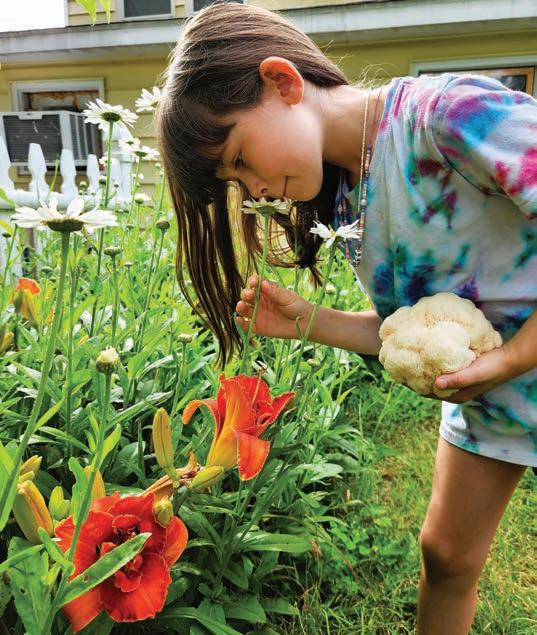
TOP: Young herbalist Availia, while holding a lion’s mane mushroom, demonstrates that daisies do have a scent – but that it is not nearly as fragrant as echinacea.
BOTTOM: Borage might just look like a beautiful flower, but it is a highly potent and versatile medicinal plant. Medicinally, the seeds of the plant are valued for their high levels of gamma-linolenic acid, which has been used for dermatitis, eczema, arthritis, neuropathy, menopausal symptoms, digestive issues, a sedative, a diuretic, for colds and flu, to increase breast milk production, and more.

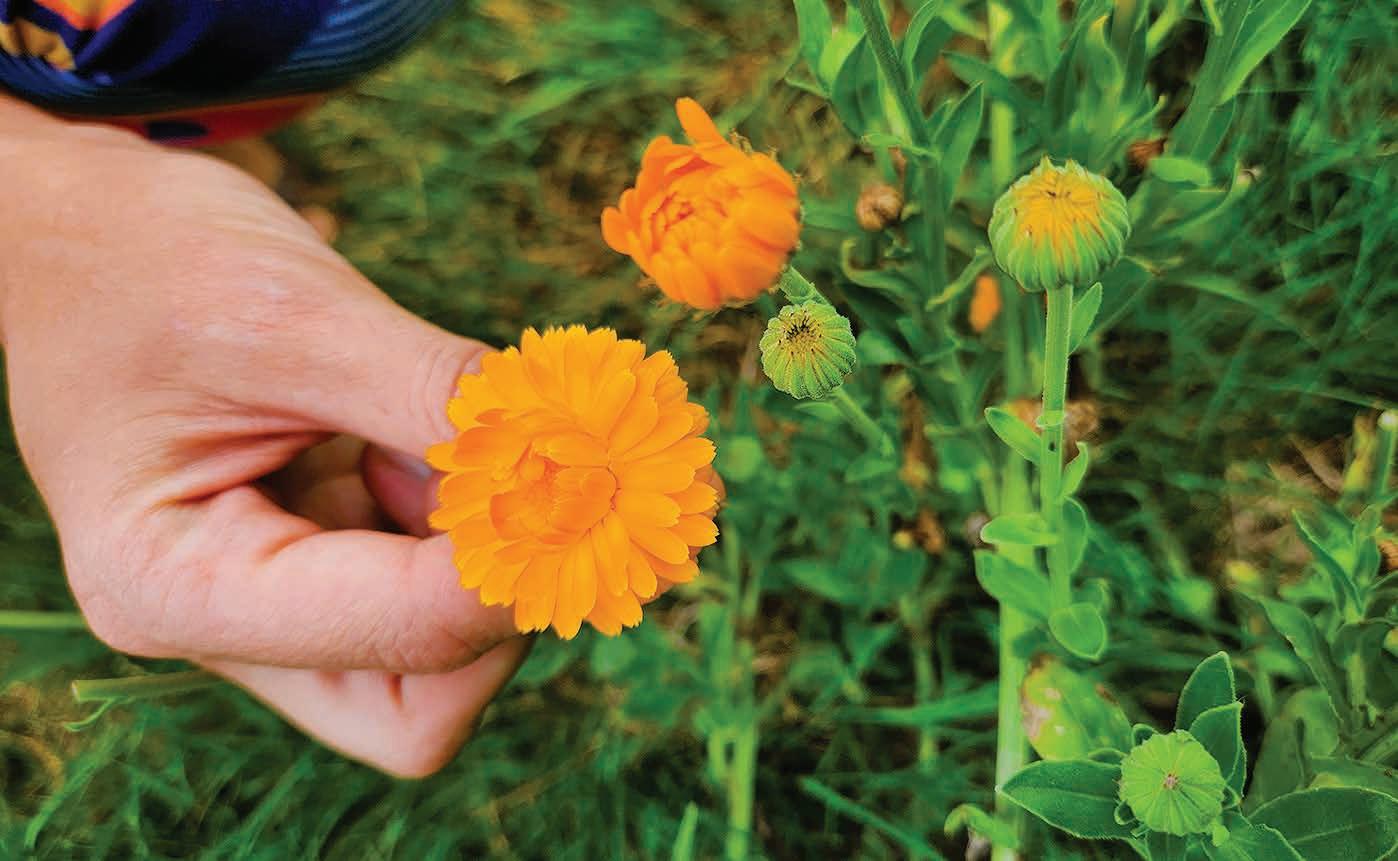
but
Relearning
from page 23
times, you plant it, and it just spreads.”
Lemon balm has been studied for its medicinal properties, which are largely centered around its use in reducing stress, improving cognitive function and mood, promoting sleep and feelings of well-being, and use as an antioxidant. However, it is also being investigated for potential antiviral properties.
What is known is that lemon balm increases levels of GABA, which is a neurotransmitter that promotes feelings of stability. Studies in the Journal Nature, under the heading of Neuropsychopharmacolo -
gy, found that lemon balm also improved memory in study participants. Its antioxidant properties are due to the compound rosmarinic acid, which shows promise in dealing with conditions of oxidative stress.
Lemon balm, “the herb that just keeps on giving,” is also helpful in dealing with digestive issues, cardiovascular issues, and reducing menstrual cramping.
“The goldenrod comes up later in the summer, and we have almost a half acre of that in the back, but the Echinacea – it’s this purple one with the pointy center. You’ve probably seen it. It grows everywhere,” said Meiswinkle, stressing the word “everywhere” and running a hand along
the tall thin stalks topped with drooping fuchsia petals. Reminiscent of a purple-pink daisy, echinacea can be identified by the cone-like brown-orange central disc. The ray florets can splay out flat like a daisy, or droop in a reflexed position. Echinacea flowers are also great for pollinators, attracting a variety of insects.
“Echinacea has a zesty spicy taste, not a heat spicy, but a tingly feeling,” said Meiswinkel. “It’s an acquired taste. Some people don’t like it. Me and Pat will drink it in a tea, but the kids won’t. That’s why we make it in a tincture, and you can tincture everything about echinacea from the flower right down to the
is
root. And, the root is most potent. It’s excellent for cold and flu symptoms, and the flower has a beautiful floral smell. It pairs really well with goldenrod.”
Goldenrod, Meiswinkel said, is also great for cold and flu symptoms – however, perhaps more interesting is its medicinal properties that help with both kidney and liver function, and as a help for those with arthritis. Working as a well established diuretic with anti-inflammatory and antimicrobial properties, goldenrod is thought to increase urine flow. In the process, it helps to flush out bacteria and smaller kidney stones. For those with arthritis, the flavonoids quercetin and kaempferol,
PHOTOS BY DANIELLE M CROSIER — HOMESTEADER MAGAZINE
Calendula is one of the main ingredients in Meiswinkel’s set of soothing skincare products,
it
also sold in tincture form and in teas.

and the saponins in the flowering portion of the plant are thought to work like an NSAID, inhibiting inflammation pathways. The flavonoids also help to protect cells from free radicals, reducing damage and promoting healing.
Before the advent of modern medicine, there used to be intentional plantings of age-old, time-tested medicinals throughout the region, Meiswinkel noted.
Earlier in the year, she and McLaughlin made the decision not to mow the unused lawn area around the
consult with somebody who knows what they’re talking about before you just go willy-nilly taking things because they are also medicine,” said Meiswinkel. “It’s important to know what you’re doing, and talk to somebody who can vouch for what is safe to take, and what and how much you should be taking.”
An example of this is goldenrod, which offers many healing, protective, and medicinal properties. However, it should never be used by breastfeeding women, or during pregnancy. Also, it shouldn’t be taken by those already on a diuretic, or those taking medications that contain lithium.
“Our mushroom tinctures, though, you can’t take too much of them. If you’re in a lot of pain, it’s fine to double the dose. That’s totally fine. Your liver is not going to fail from that – like it is if you take too much Tylenol,” explained Meiswinkel. “So, it’s a significantly safer option for long term use – to use something herbal rather than something that has a laundry list of side effects.”
across the back of the property.
“People always ask me, ‘When is the best time to forage for this and that?’ And, it’s like, well – who knows – because we have no predictable seasons anymore. You know, morels were out, like, a month early this year. Last year, there were two seasons of them, which was unheard of. We don’t get out foraging much anymore, because we have so much work to do on the farm – but we can tell that with our own crops that we have here on the farm.”
Despite the unpredictability that a changing climate brings, Meiswinkel’s understanding of the intricacies and responsibilities of producing quality tinctures and teas is fairly steadfast. Along the journey of growing her family and farm, Meiswinkel is rediscovering the knowledge lost to this generation – the knowledge that she hopes to pass on to like-minded community members who might be interested in learning alongside her.
house, and to do a rewilding experiment, “For one reason or another, we just hadn’t gotten to mowing yet by June. Then, we were like, ‘You know what? Why are we mowing all this space that we’re not even walking on? Why don’t we see what comes up?’ And, we found so much medicine.”
“[Natural medicines] are actually much safer, and there’s far less side effects, and there’s usually less contraindications with taking one with another –not that there’s none. You should always, you know,
Meiswinkel ticked off the different herbs and flowers in the back and front of the property, indicating what the typical seasons were that she harvested them. She usually looks to harvest dandelions and red clover earlier in the growing season, while goldenrod is much later, and so forth.
“Everything is a little bit different, though, with climate change. You never know what is going to happen with what plant or what mushroom,” said Meiswinkel, looking out
In essence, Meiswinkel has admittedly been “relearning what our ancestors already knew.”
It is at the farmers markets that you will find her, sharing the knowledge and skills that she has with others.
You will also find her at workshops, held in her own backyard and run with her husband and children. Her products can be purchased online at thesoleconnectionfarm.com; at the market stand at 9 Walker Meadows; and at the Bennington, Arlington, Manchester, and Ludlow Farmers Markets.
Finley helps to select the largest and bluest blueberries on the bush.
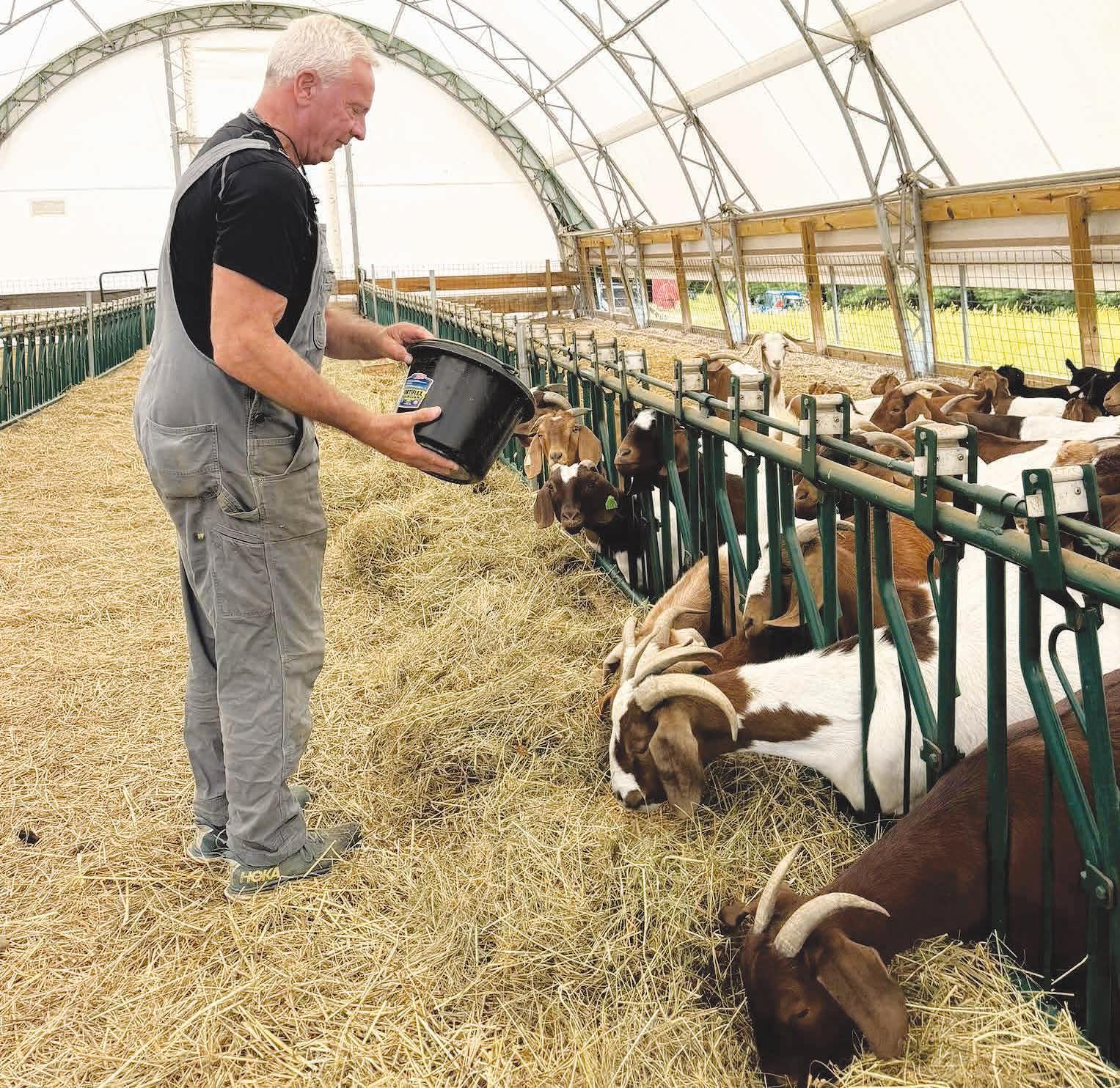
Geannelis Farm brings ethically raised goat meat to Bennington

By Ahmad Yassir Homesteader Magazine
In the rolling fields of Bennington, Geannelis Farm is carving out a new space in Vermont agriculture by raising goats for meat with an emphasis on animal welfare and ethical practices. The farm, founded by retired veterinarian Dr. Peter
Geannelis, supplies chefs, food lovers and families across Southern Vermont and Upstate New York with a protein that is both flavorful and responsibly sourced.
FROM VETERINARY MEDICINE TO FARMING
Geannelis spent more than three decades practicing veterinary medicine in Bennington, where he
owned and operated Mount Anthony Veterinary Hospital. He sold the practice in 2021 and has since shifted his focus to farming.
“Animal health and welfare always come first,” Geannelis said. “When you’ve spent your life ensuring animals live better, longer and healthier lives, you can’t approach farming
any other way.”
That experience guides the way goats are raised at Geannelis Farm. Animals are given space to graze and live naturally, with veterinary oversight ensuring proper nutrition and humane care. The result, he said, is meat that reflects both ethical standards and high quality.
EXPANDING PALATES
Although goat meat is one of the most consumed proteins globally, it remains relatively uncommon in the United States. Known for being lean and nutrient-dense, it contains less cholesterol and saturated fat than beef. With Vermont’s strong farmto-table culture, Geannelis hopes to expand local awareness of the benefits of goat meat while offering a transparent and trustworthy source.
“Consumers want to know where their food comes from and how it’s raised,” Geannelis said. “Here, they can see the whole story.”
DEFINING “ETHICALLY SOURCED”
At Geannelis Farm, ethics are defined by three principles: humane treatment of animals, environmental responsibility and community benefit.
Goats are raised in stressfree, pasture-based systems.
Soil health and pasture rotations reduce environmental impact.
Local sourcing keeps dollars in the community and strengthens the regional food system.
For customers, that means buying more than just meat, it means supporting a way of farming that prioritizes care and responsibility.
A RECORD OF COMMUNITY SERVICE
Geannelis is well known in Bennington for his community involvement. In 2017, he donated equipment, supplies and more than 30 hours of labor to restore the Southern Vermont College baseball field. He has also coached basket-
ball and baseball, provided uniforms, and built fields for youth sports.
“His high energy level motivated all of us,” said Mark Klauder, then the college’s director of facilities, at the time of the project. Baseball coach Adam Skonieczki called his contributions “invaluable” and reflective of his character.
Geannelis has also operated Geannelis Tree Farms since 1988, supplying locally grown Christmas trees to families across the region. That tradition, like his farming, ties his work closely to the community.
LOOKING AHEAD
As interest in sustainable and ethical food grows, Geannelis Farm is positioned to meet new demand. For Geannelis, the mission remains straightforward.
“Our goal is simple,” he said. “Raise animals the right way, provide healthy food for our neighbors and keep our community strong.”
For Southern Vermont and Upstate New York, that means access to goat meat produced with care from start to finish. For Geannelis, it marks the next chapter in a career and a life dedicated to animals, agriculture and community.
Contact:
Geannelis Farm
70 Riverside Drive East Bennington, VT 05201 Phone: 802-375-3203


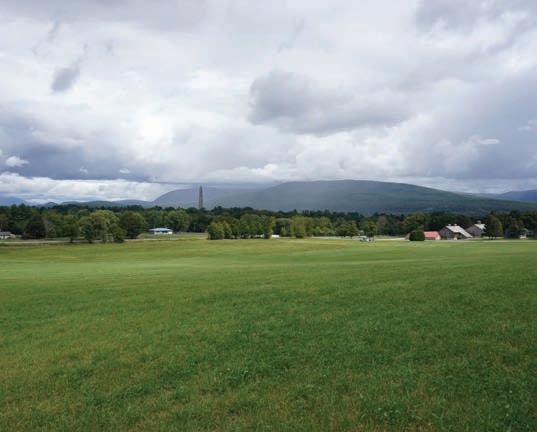
PHOTOS COURTESY OF GEANNELIS FARM

Beautify and expand your indoor garden



Trimming with a sharp houseplant pruners or micro snips will improve a houseplant’s growth habit and size.
PHOTO COURTESY OF CORONA TOOLS
By Melinda Myers Homesteader Magazine
Keep your houseplants looking their best with a bit of pinching, trimming and cleanup. A few well-placed snips can improve a plant’s appearance and create cuttings to start new plants. Start by removing any dead stems and leaves. Improve the overall beauty of spider plants, dracaenas and palms by trimming away the brown leaf tips caused by fluoride from tap water accumulating in the leaves. Avoid the problem by using rainwater, well water or water treated by reverse osmosis.
Trimming to improve the plant’s growth habit and size can provide immediate and long-term benefits. Removing a small or large portion of the stem tip encourages the plant to form more branches and compact growth. When you remove the stem tip you reduce the amount of the growth hormone auxin that promotes upward growth and discourages branching. Encourage more branching without greatly reducing the plant’s size with a soft pinch. Remove just the uppermost portion of the stem where new leaves
are developing. Use a hard pinch to remove the tip and several inches of the leafy stem when you want to reduce the overall size and promote fuller growth on leggy plants.
Make a clean cut using sharp micro snips or pruners like Corona’s houseplant pruners (coronatools. com). The rust proof, stain-
Use the trimmings from heirloom and non-patented plants to expand your houseplant collection.
less steel blades can cut up to 1/4” in diameter and are shaped to make it easier to cut the intended leaves and stems. Your plant will look better, and the wound will close more quickly.
Avoid leaving stubs and keep the plant looking its best by making cuts above a set of healthy leaves or a node, the place where leaves once grew. Pruning elsewhere distracts from
the plant’s appearance and the stubs create entryways for insects and disease.
When you finish pinching and pruning, do a bit of cleanup. Use a dry or damp soft cloth to wipe away any dust that accumulates on the leaves. Use a cosmetic brush to clean fuzzy-leaved plants like African violets. Or give your plants a gentle warm shower in the sink or tub. Wrap the pot in a plastic bag if needed to keep soil out of the drain and plumbing. Removing the dust allows more light to reach the leaves for photosynthesis which is essential for plant growth.
Use the trimmings from heirloom and non-patented plants to expand your houseplant collection. It’s easy to start new plants from leaf stem cuttings of various houseplants like inch plants, philodendron, pothos, dieffenbachias, dracaenas, and many more. Use a sharp knife, snips or bypass pruners to cut three- to six-inch-long pieces from firm, mature non-woody stems.
Remove the lowest leaf or two from the stem where roots will form. Stick the cutting in a small container filled with vermiculate, perlite or a well-drained
potting mix. Loosely cover the potted cutting with a plastic bag left open at the top to increase the humidity around the cutting while it forms roots. Set the container in a bright location out of direct sun for several weeks as the roots develop. Once rooted, pot it up and place it in a space that receives the sunlight it prefers.
You’ll be amazed at how a bit of grooming and propagating can perk up a tired indoor garden. Share or trade extra rooted cuttings with family and friends so each of you can grow your indoor garden and memories.
Melinda Myers has written more than 20 gardening books, including the Midwest Gardener’s Handbook, 2nd Edition and Small Space Gardening. She hosts The Great Courses “How to Grow Anything” instant video series and the nationally syndicated Melinda’s Garden Moment radio program. Myers is a columnist and contributing editor for Birds & Blooms magazine and was commissioned by Corona Tools for her expertise to write this article. Her website is www.MelindaMyers.com.







Slipstream Farm serves up mushrooms at local farmers markets
By Chris Mays Homesteader Magazine
NEWFANE — Jon Deloge, co-owner of Slipstream Farm, enjoys being part of the local food economy and offering a unique or unusual product.
There’s some trust and salesmanship involved in his business and getting customers to eat some
mushrooms they never ate before. He compared it to selling meat at a farmers market.
“People can be afraid of mushrooms,” he said.
Deloge runs the farm at their home in Newfane with his wife Lizzie Devane. They started selling mushrooms in May 2021 at the Brattleboro Farmers Market. Initially, they offered
mostly blue oyster and lion’s mane mushrooms.
Mushrooms are grown at the farm in different ways. For some varieties, the couple uses an organic fruiting box from Maine. Others involve inoculating bags of grain.
This year, some mushrooms are being grown under shade cloth. Also, compost is being made from
mushroom spent substrate.
The farm currently sells blue, yellow, pink and black pearl; two types of lion’s mane; comb tooth; pioppino; chestnut and shiitake. The mushrooms are sold at farmers markets in Brattleboro and Londonderry on Saturdays, and sometimes Putney on Sundays.
Deloge said he likes the farmers markets, which
Jon Deloge, co-owner of Slipstream Farm, helps Michael Taylor with an order of mushrooms at the Brattleboro Farmers Market.
PHOTOS BY KRISTOPHER RADDER — HOMESTEADER MAGAZINE
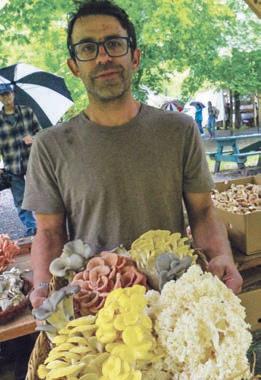

were never a part of his life before moving here.
“I just enjoy being part of that community of really hard working, self starting people providing really good food to the area,” he said.
Deloge expressed interest in dedicating more space in his barn to growing medicinal mushrooms, primarily cordyceps and some varieties of reishi.
“Lion’s mane is particularly good for the brain and nervous system,” he said. “Reishi is sort of considered the king of the medicinal mushrooms.”
Reishi and chaga mushrooms are known to offer immune system support, Deloge said.
Raised beds recently were built at the farm. Herbs and greens are being grown in the soil as “an experiment to see if we can grow a whole season in mushroom compost,” Deloge said.
“So far, so good,” he said.
Deloge considers the farm his “primary gig” and Devane works as director of development and communications for Somerville
Community Corporation, an organization focused on affordable housing, just outside of Boston. Their two children, Leo, 3, and River, 1, also keep the couple busy.
For about 16 years, Deloge had a landscape design business in Cambridge, Mass.
“I was about to really grow and I was taking all these different country club accounts and then COVID hit,” he said.
As weddings were cancelled due to the pandemic, Deloge ended up losing country club accounts. He said he was “coming to the end of my rope with the business ... then Lizzie had the opportunity to work remotely permanently with her job.”
Deloge said he’d been wanting to transition to a more homesteading type of lifestyle for years, so the couple started looking for houses. At the time, he was taking classes on thermal composting. He was learn-
ing how to identify different microorganisms in the soil with a microscope and tailor make items. He said he became “really interested in fungi that way.”
Watching a video about soil on YouTube one day, another clip about a mushroom farmer came up afterwards. Deloge said he watched for a few minutes, and “that was that. I just went down the rabbit hole,” he said.
Family matters also were a major factor in starting the farm. Deloge said Lizzie “really wanted to have
kids.”
“I was sort of on the fence,” said Deloge, who has an adult child who’s 30 years old and about to get married.
Moving here and finding a way to work from home was the compromise, Deloge said.
“My interest in fungi came from basically studying soil microbiology and the appeal of growing mushrooms is that I get to be home,” Deloge said.
“That’s the big one.”
Deloge described being “grateful to be here.”

Mushrooms on display at the Slipstream Farm stand at the Brattleboro Farmers Market.
Jon Deloge, co-owner of Slipstream Farm, holds some of the mushrooms he sells at the Brattleboro Farmers Market.

Food for Thought with Kat | Katharine A. Jameson Christmas Cheer... or Fear?
By Katharine A. Jameson Homesteader Correspondent
Thanksgiving leads us into the long, cold march through Christmas and New Year’s, toward spring. Spring is the reward we get for making it through the snow only to embrace mud season, but the first sign of a budding tree fills us with rapture so palpable, many of us jump for joy. I went to college in western New York where the lake effect snow buried us often. Icicles formed on the hood of my puffy Tommy Hilfiger jacket as I trod across the quad to class.
Winters in Vermont can be just as brutal, but never had I walked around in so much snow as I did when I arrived in Syracuse. The first glimpse of spring sponsored many a frat guy to move his sofa onto the lawn in front of their house. The feeling of
spring inspired excitement, an animated exuberance that matched little else on a college campus.
The Thanksgiving snow we had this year blanketed us before many of us were ready. The ground had yet to freeze after consistently warm temps, and I wondered if the plants were ready themselves to receive a winter blanket so early. In the last 38 years, I don’t remember ever having a white Thanksgiving, though we welcomed it with open arms this year. My four-year-old son asked me if the animals were ready for the winter, and I began to think – what is it in nature that signals to animals to get ready for winter? They don’t have a calendar or an iPhone. Our temperatures have been so mercurial of late that the gradual chill we used to get rarely sets in now adays. As
animals ready themselves, how might we prepare for the joys and the tolls that winter brings?
The last full winter I spent in Vermont, I was 27-yearsold. Alone on a March day, I had set to painting a living room wall, when a late spring snow began. It didn’t stop. It wouldn’t stop, and I needed it to. I needed sunshine and grass. I needed a warm breeze, and yet was stuck in a perpetual winter. I remember staring out the window feeling despondent. With each new layer of white that fell, so did my tears.
SEASONAL SADNESS
Elvis wasn’t the only one to have experienced a blue Christmas. Commonly known as seasonal depression, seasonable affective disorder (SAD) is typically seen in adults, and most often in women who have bypassed
their 20s (to add insult to injury). It’s easy to feel blue when the days are so short they’re barely noticeable. As the clock falls back, we race through the winter solstice with few glimpses of spring, flowers or fresh fare. SAD tends to set in around late fall or earl winter, just in time for the holidays. Come the onset of mud season, symptoms tend to diminish for most people.
SEASONAL SLEEPY
Our bodies’ circadian rhythm is what wakes us up, puts us to bed and makes us jet lagged. No matter what the clock says, our bodies know better. Other than regulating our internal clock, our circadian rhythm is integral to regulating our digestion, hormones and body temperature.
Our body makes melatonin when it’s dark, so when it
METRO
gets darker earlier, we make more melatonin, which has been linked to SAD. Daytime fatigue and increased sleepiness are symptoms of SAD, as are typically depressive symptoms like loss of interest in social activities, hopelessness, decreased libido, lack of ability to focus and mental fogginess, weight gain and anxiety, among others.
SEASONAL SOLUTIONS
While hopping on a plane and going to Florida in the dead of winter sounds like the best plan, here are some more realistic solutions:
Keep spring alive – second best to picking fresh fare from your garden is going to the pantry to find some of summer’s best memories. Even if you’re not a canner or planner (which I am not,) it’s easy to keep a few fresh things around for winter.
Cut and freeze some fresh fruit. It’s easy to store fruit in wax paper-lined plastic bags or glass containers.
Preserving fruit. While my grandmother made a mean guava jelly, she never taught me to can. I once tried to can some fresh peaches, but decidedly did not incorporate any sugar, so the process didn’t work, or it didn’t taste like it had worked. Saving summer in a jar just might breathe some spring into our step.
A great option (that requires zero planning) is to buy frozen fruit and make some impromptu preserves! You needn’t even can it, just use them right away to happily remember the sweet and decadent charms of summer.
TAKE STEPS TO ...
Lighten up: Some have found that sunlight has helped to lighten their mood. A sunny window can do wonders, but we can’t always rely on that during the dead of winter. Some swear by light therapy and many companies
market lights specifically for SAD.
Walk it off: Although it may be the last thing we want to do when we’re feeling down, talking a short walk can make all the difference. Not only does it get our blood flowing, but physical activity has been linked to reduced anxiety and general depression to enhanced mood.
Vitamin D: This is intricately connected to mood, so it may come as no surprise that researchers have found a connection between low vitamin D levels and SAD (as well as general depression and anxiety). Add seafood, shellfish, eggs and dairy to your diet to get more D, or get a good quality supplement.
Limit caffeine: Though it sounds counterintuitive when we’re sleepy, caffeine has been shown to inhibit the absorption of vitamin D. So, if we are feeling especially low, cut the coffee and grab for the D to see if you can observe a benefit.
Reach out: Although we may gravitate toward isolating ourselves when we are feeling down and out, the worst thing we can do is to steer clear of friends and family during the holidays. Reach out to loved ones or pick up the phone. It may be hard, but keep in mind that being around people, as counter-intuitive as it may feel, has been proven to enhance mood.
Keep it simple: Many of us feel the need to reinvent ourselves in the new year. Not only does this breed the idea that there was something wrong with us to begin with, it’s rarely achievable (or necessary). Keep resolutions simple. Shoot for a daily walk to start or a singular dietary change. Try not to focus on numbers on the scale, as this just focuses more attention on the things we don’t like. Bring positive is half the battle.
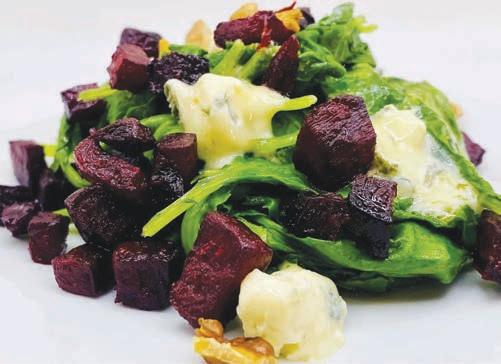
Wilted Spinach Bleu Cheese Beet Salad
Ingredients:
1 large beet, peeled and diced
1 tablespoon olive oil to toss beet
Salt and pepper, to taste
1/4 teaspoon garlic powder
1/4 cup walnuts
1/2 shallot, minced
1/2 cup extra virgin olive oil
1/4 cup sherry vinegar
1/4 teaspoon Dijon mustard
1/2 teaspoon spicy honey
1 bunch baby spinach, washed 1/2 cup bleu cheese crumbles
1. Preheat oven to 400°F.
2. Place diced beets on tray and toss with olive oil, garlic powder, salt and pepper. Bake for 20 minutes, then toss. Bake for another 15-20 minutes, or until tender. Remove from oven and allow to cool.
3. Reduce oven temperature to 300°F. On another tray, place walnuts and bake for 3-5 minutes or until lightly toasted.
For the dressing: Mix shallot, oil, vinegar, mustard, salt and pepper (to taste), and honey and shake vigorously. In a sauté pan, add spinach and heated until lightly wilted. Place on serving plate immediately, add bleu cheese while still warm. Pour dressing over spinach and sprinkle with beets and toasted walnuts. Serve while warm.
Katharine A. Jameson, a certified nutrition counselor who grew up in Williamsville and Townshend, writes about food and health for Vermont News & Media. For more tricks, tips and hacks, find her on Instagram: @foodforthoughtwithkat
WANT YOUR RECIPE FEATURED?
Go to newenglandhomesteader.com to submit the recipe and photos of you and your loved ones making delicious food!
PROVIDED PHOTO
By
Fight the winter blues with double amaryllis
Add unique flare to this winter’s indoor garden and décor with double amaryllis. The several layers of colorful petals are sure to make a statement wherever they are displayed.
Start the amaryllis season with early blooming varieties grown in the southern hemisphere. Double Alaska features frilly, fully double white flowers with a lime green center. Order bulbs early, store them in a cool, dry, dark location and plant these early blooming bulbs by November 1st if you want flowers for the holiday. Keep the color coming throughout the winter by growing a variety of other double amaryllis grown in the Northern hemisphere that begin blooming in January. Plant a few bulbs every three weeks to extend your enjoyment for several months.
Watch the colors change on Double Giant Amadeus amaryllis. The petals start as mostly white with a fine red outline. As the flowers mature, the color intensifies to a blushing pink, coral and salmon.
Grow Double Sweet Nymph (longfield-gardens.com) for a bit of a romantic charm. The layers of creamy white petals are covered with coral pink stripes. If you like the traditional
red amaryllis, you will enjoy the giant red flowers of Double King. Each bulb produces three stems with four or more blooms that open at different times to extend your enjoyment.
The candy cane striped narrow petals of Double Doublet are sure to catch your attention. Each flower is a bit different, adding to its uniqueness. Watch as the three stems grow, producing as many as a dozen flowers from each bulb. Enjoy weeks of artistic blooms when you grow Double Aphrodite amaryllis. The ruffled white petals have a narrow red edge and lime green center. The fine red brushstrokes that extend from the petal tips add to this amaryllis’s charm.
Plant your amaryllis bulbs in a quality potting mix with the top half above the soil surface. Grow a single bulb in a pot that is seven to eight inches deep and five to six inches across with drainage holes. Or group several bulbs together in a larger container. Water the potting mix thoroughly and place the container in a cool sunny location. Continue to water thoroughly but only often enough to keep the soil barely moist. Add a bit of elegance and ease of care by going soilless. Place several inches of pebbles in the bottom of a glass vase or watertight container. Cover the

pebbles with water. Set the bulb on top of the pebbles, adding more stones around the bulb to hold it in place. Leave the top one third of the bulb exposed. Add water as needed to maintain the water level just below the bulb.
Now relax and wait a month or more for your amaryllis bulb to wake up and start growing. Water more often once sprouts appear. Enjoy the transformation as the bulb turns into a flowering plant over the next few weeks.
Growing amaryllis indoors will keep you gardening all year long, providing mood-boosting benefits and
stress relief. Plus, the colorful blossoms are sure to brighten your winter days.
Melinda Myers has written more than 20 gardening books, including the Midwest Gardener’s Handbook, 2nd Edition and Small Space Gardening. She hosts The Great Courses “How to Grow Anything” instant video series and the nationally syndicated Melinda’s Garden Moment radio program. Myers is a columnist and contributing editor for Birds & Blooms magazine and was commissioned by Corona Tools for her expertise to write this article. Her website is www.MelindaMyers.com.
The artistic blooms of Double Aphrodite amaryllis have ru ed white petals with a narrow red edge and lime green center.
Melinda Myers Homesteader Magazine
PHOTO COURTESY OF LONGFIELD-GARDENS.COM





















